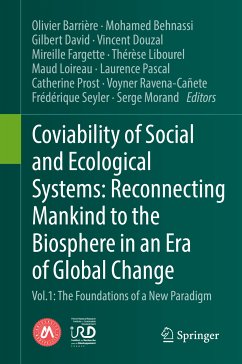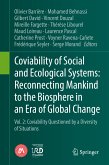Coviability of Social and Ecological Systems: Reconnecting Mankind to the Biosphere in an Era of Global Change (eBook, PDF)
Vol.1 : The Foundations of a New Paradigm
Redaktion: Barrière, Olivier; Prost, Catherine; Pascal, Laurence; Loireau, Maud; Libourel, Thérèse; Fargette, Mireille; Douzal, Vincent; David, Gilbert; Behnassi, Mohamed; Morand, Serge; Seyler, Frédérique; Ravena-Cañete, Voyner


Alle Infos zum eBook verschenken

Coviability of Social and Ecological Systems: Reconnecting Mankind to the Biosphere in an Era of Global Change (eBook, PDF)
Vol.1 : The Foundations of a New Paradigm
Redaktion: Barrière, Olivier; Prost, Catherine; Pascal, Laurence; Loireau, Maud; Libourel, Thérèse; Fargette, Mireille; Douzal, Vincent; David, Gilbert; Behnassi, Mohamed; Morand, Serge; Seyler, Frédérique; Ravena-Cañete, Voyner
- Format: PDF
- Merkliste
- Auf die Merkliste
- Bewerten Bewerten
- Teilen
- Produkt teilen
- Produkterinnerung
- Produkterinnerung

Hier können Sie sich einloggen

Bitte loggen Sie sich zunächst in Ihr Kundenkonto ein oder registrieren Sie sich bei bücher.de, um das eBook-Abo tolino select nutzen zu können.
This book considers the principle of 'sustainable development' which is currently facing a growing environmental crisis. A new mode of thinking and positioning the ecological imperative is the major input of this volume. The prism of co-viability is not the economics of political agencies that carry the ideology of the dominant/conventional economic schools, but rather an opening of innovation perspectives through science. This volume, through its four parts, more than 40 chapters and a hundred authors, gives birth to a paradigm which crystallizes within a concept that will support in overcoming the ecological emergency deadlock.…mehr
- Geräte: PC
- ohne Kopierschutz
- eBook Hilfe
- Größe: 14.42MB
![Coviability of Social and Ecological Systems: Reconnecting Mankind to the Biosphere in an Era of Global Change (eBook, PDF) Coviability of Social and Ecological Systems: Reconnecting Mankind to the Biosphere in an Era of Global Change (eBook, PDF)]() Coviability of Social and Ecological Systems: Reconnecting Mankind to the Biosphere in an Era of Global Change (eBook, PDF)97,95 €
Coviability of Social and Ecological Systems: Reconnecting Mankind to the Biosphere in an Era of Global Change (eBook, PDF)97,95 €![Handbook of Climate Change and Biodiversity (eBook, PDF) Handbook of Climate Change and Biodiversity (eBook, PDF)]() Handbook of Climate Change and Biodiversity (eBook, PDF)121,95 €
Handbook of Climate Change and Biodiversity (eBook, PDF)121,95 €![The Beachcomber's Guide to Marine Debris (eBook, PDF) The Beachcomber's Guide to Marine Debris (eBook, PDF)]() Michael StachowitschThe Beachcomber's Guide to Marine Debris (eBook, PDF)36,95 €
Michael StachowitschThe Beachcomber's Guide to Marine Debris (eBook, PDF)36,95 €![Human and Environmental Security in the Era of Global Risks (eBook, PDF) Human and Environmental Security in the Era of Global Risks (eBook, PDF)]() Human and Environmental Security in the Era of Global Risks (eBook, PDF)73,95 €
Human and Environmental Security in the Era of Global Risks (eBook, PDF)73,95 €![Mathematical Advances Towards Sustainable Environmental Systems (eBook, PDF) Mathematical Advances Towards Sustainable Environmental Systems (eBook, PDF)]() Mathematical Advances Towards Sustainable Environmental Systems (eBook, PDF)73,95 €
Mathematical Advances Towards Sustainable Environmental Systems (eBook, PDF)73,95 €![Mental Modeling Approach (eBook, PDF) Mental Modeling Approach (eBook, PDF)]() Matthew D. WoodMental Modeling Approach (eBook, PDF)73,95 €
Matthew D. WoodMental Modeling Approach (eBook, PDF)73,95 €![Disaster Risk Communication (eBook, PDF) Disaster Risk Communication (eBook, PDF)]() Disaster Risk Communication (eBook, PDF)97,95 €
Disaster Risk Communication (eBook, PDF)97,95 €-
-
-
Dieser Download kann aus rechtlichen Gründen nur mit Rechnungsadresse in A, B, BG, CY, CZ, D, DK, EW, E, FIN, F, GR, HR, H, IRL, I, LT, L, LR, M, NL, PL, P, R, S, SLO, SK ausgeliefert werden.
Hinweis: Dieser Artikel kann nur an eine deutsche Lieferadresse ausgeliefert werden.
- Produktdetails
- Verlag: Springer International Publishing
- Seitenzahl: 728
- Erscheinungstermin: 12. März 2019
- Englisch
- ISBN-13: 9783319784977
- Artikelnr.: 55458368
- Verlag: Springer International Publishing
- Seitenzahl: 728
- Erscheinungstermin: 12. März 2019
- Englisch
- ISBN-13: 9783319784977
- Artikelnr.: 55458368
- Herstellerkennzeichnung Die Herstellerinformationen sind derzeit nicht verfügbar.







